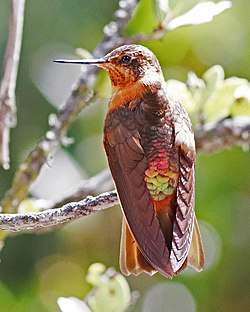Shining sunbeam
The Shining sunbeam (Aglaeactis cupripennis) is a species of hummingbird in the family Trochilidae. It is found in Colombia, Ecuador, and Peru. Its natural habitats are subtropical or tropical moist montane forest and subtropical or tropical high-altitude shrubland.
| Shining sunbeam | |
|---|---|
.jpg) | |
| Adult Shining sunbeam. | |
| Scientific classification | |
| Kingdom: | Animalia |
| Phylum: | Chordata |
| Class: | Aves |
| Order: | Apodiformes |
| Family: | Trochilidae |
| Genus: | Aglaeactis |
| Species: | A. cupripennis |
| Binomial name | |
| Aglaeactis cupripennis Bourcier, 1843 | |
 | |
| Geographical range of A. cupripennis | |
Description

Short straight bill, male metallic dusky brown above, dark on crown and ear-coverts. Area of glittering purple on lower back becoming coppery on rump and green on uppertail coverts. Face and underparts cinnamon-rufous. Tail bronzy olive, lateral feathers with rufous on inner webs. Female similar to male except lack most of glitter on back and rump.[2]
Habitat and distribution
The shinning sunbeam is indigenous to tropical regions, more specifically Ecuador, Peru, and Columbia; however, this species has different mating seasons in each of these countries. In Ecuador the mating season ranges from February to April, while in Columbia the season last from March to September, and in Peru the season only occurs biannually in November and April. [3] The fact that all three neighboring habitats all have the month of April in common suggest that the shinning sunbeam originated from the same location and later dispersed.
Behavior and ecology
Diet
Shining sunbeams are mainly nectarivorous, taking nectar from flowers of many genera of terrestrial flowers such as Embothrium, Puya, and Fuchsia[4]; however, they also seize insects and arthropods, usually in mid-air.
Breeding
Aglaeactis cupripennis typically breeds year-round depending on its location; in Colombia, they breed from March to September and February to April in Ecuador[4]. They lay two tiny, white eggs, which are incubated up to 18 days (only by the female), and fledge at around 27 days.
References
- BirdLife International (2012). "Aglaeactis cupripennis". IUCN Red List of Threatened Species. 2012. Retrieved 26 November 2013.CS1 maint: ref=harv (link)
- Ridgely, Robert and Paul Greenfield. The Birds of Ecuador. Volume II: Field Guide. Cornell, 2001
- Pavan, Lucas I.; Jankowski, Jill E.; Hazlehurst, Jenny A. (2020-02-14). "Patterns of territorial space use by Shining Sunbeams ( Aglaeactis cupripennis ), tropical montane hummingbirds". Journal of Field Ornithology: jofo.12321. doi:10.1111/jofo.12321. ISSN 0273-8570.
- Schuchmann, K.L. and P. F. D. Boesman (2020). Shining Sunbeam (Aglaeactis cupripennis), version 1.0. In Birds of the World (J. del Hoyo, A. Elliott, J. Sargatal, D.A. Christie, and E. de Juana, Editors). Cornell Lab of Ornithology, Ithaca, NY, USA. https://doi.org/10.2173/bow.shisun1.01.
